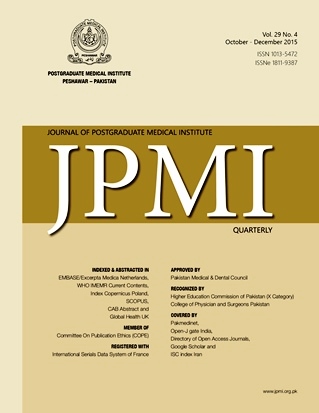REASONS OF PATIENTS TRANSFER FROM PERIPHERAL TEACHING AND NON TEACHING HOSPITALS TO A SURGICAL UNIT, LADY READING HOSPITAL PESHAWAR: A PILOT STUDY
Main Article Content
Abstract
Methodology: This is a descriptive cross-sectional study conducted in surgi -cal unit "C" Lady Reading Hospital (LRH) Peshawar from February 28 to Sep-tember 14, 2014, using consecutive non-purposive sampling technique. All
patients admitted in our unit living outside the catchment area of Peshawar
were included. Age, gender, address, reason for referral and perception of the
patients about Lady Reading Hospital Peshawar was recorded on a proforma.
Data was analyzed using SPSS version 20. Mean and standard deviation was
calculated for quantitative output responses and frequency and percentages
for qualitative output responses. Chi-square test was applied on the variables
when compared and p value of <0.05 was considered significant.
Results: Total patients received in the study period of (six and half months)
were 195.Out of these 75.4% were male. The mean age of patients was 37.2+
17.49 years. The percentage admitted via emergency was 88.7%. Out of 195
patients, 147(75.4%) attended a health facility before coming to LRH. The rea-sons given for referral was lack of equipment, lack of staff, lack of ICU, lack of
specialty, lack of out of hours services and seropositivity given in 88(59.8%),
74(50.3%),71(48.2%), 70(47.6%), 70 (47.6%) and 04 (2.7%) patients respectively.
Dissatisfaction towards the local health facilities was shown by 137 (70.3%).
Conclusion: The peripheral health care system is being underutilized result-ing in excessive burden on tertiary care health facilities. It is therefore import -ant to address the problems and to implement a structured referral system.
patients admitted in our unit living outside the catchment area of Peshawar
were included. Age, gender, address, reason for referral and perception of the
patients about Lady Reading Hospital Peshawar was recorded on a proforma.
Data was analyzed using SPSS version 20. Mean and standard deviation was
calculated for quantitative output responses and frequency and percentages
for qualitative output responses. Chi-square test was applied on the variables
when compared and p value of <0.05 was considered significant.
Results: Total patients received in the study period of (six and half months)
were 195.Out of these 75.4% were male. The mean age of patients was 37.2+
17.49 years. The percentage admitted via emergency was 88.7%. Out of 195
patients, 147(75.4%) attended a health facility before coming to LRH. The rea-sons given for referral was lack of equipment, lack of staff, lack of ICU, lack of
specialty, lack of out of hours services and seropositivity given in 88(59.8%),
74(50.3%),71(48.2%), 70(47.6%), 70 (47.6%) and 04 (2.7%) patients respectively.
Dissatisfaction towards the local health facilities was shown by 137 (70.3%).
Conclusion: The peripheral health care system is being underutilized result-ing in excessive burden on tertiary care health facilities. It is therefore import -ant to address the problems and to implement a structured referral system.
Article Details
How to Cite
1.
Faraz A, Ali IS, Haq IU, Khan M. REASONS OF PATIENTS TRANSFER FROM PERIPHERAL TEACHING AND NON TEACHING HOSPITALS TO A SURGICAL UNIT, LADY READING HOSPITAL PESHAWAR: A PILOT STUDY. J Postgrad Med Inst [Internet]. 2016 Jan. 3 [cited 2025 Dec. 5];29(4). Available from: https://jpmi.org.pk/index.php/jpmi/article/view/1846
Issue
Section
Original Article
Work published in JPMI is licensed under a
Creative Commons Attribution-NonCommercial 2.0 Generic License.
Authors are permitted and encouraged to post their work online (e.g., in institutional repositories or on their website) prior to and during the submission process, as it can lead to productive exchanges, as well as earlier and greater citation of published work.


